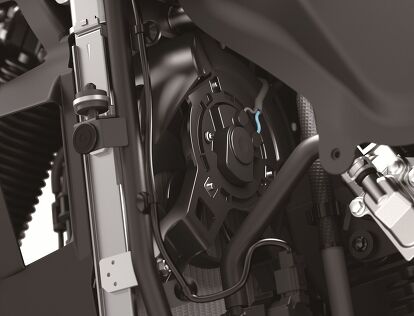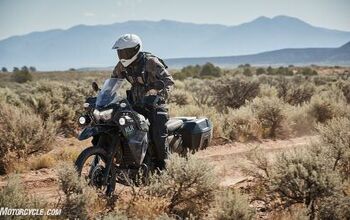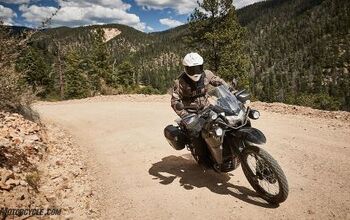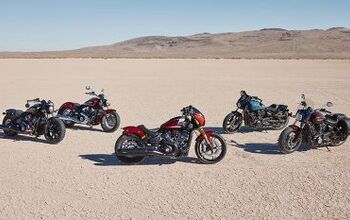Kawasaki Is Bringing The KLR650 Back For 2022

It's new and improved, but also kinda the same.
Good news, dual-sport fans; the Kawasaki KLR650 is back. One of Kawasaki’s most popular models since its introduction in 1987, the return of the KLR650 for the 2022 model year (to be released in the 2021 calendar year – yeah, we know it’s confusing) is sure to bring a huge smile on the faces of those who are intrigued by the rise of adventure bikes lately, but want something more… utilitarian.
We wondered what would be replacing the KLR after it was nixed off the Team Green lineup following the 2018 model year. Originally introduced in 1987 with its only significant update coming in 2008, the KLR650 lasted another decade before Kawi pulled the plug, riding on the back of its cult-like popularity all this time. An iteration of the Versys 650 seemed like an obvious successor, but as it turns out, Kawi decided all along the KLR wasn’t going anywhere. It was just getting freshened up.
KLR fans will instantly recognize the bike’s silhouette, but beneath the modified looks (which we’ll get into later) comes another recognizable relic: the engine. The 652cc liquid-cooled Single has proven to be as reliable as a stone, due in part to its simplicity including the Keihin CVK-40 carburetor that was rumored to be developed by Fred Flintstone.
Old Reliable Is Back
Times change, of course, and that means the carb is gone, in favor of modern electronic fuel injection with a 10-hole injector. Rue this change all you want, but the sheer superiority of EFI is hard to argue, especially when it’s cold out or you’re at high elevation. Having an O2 sensor as a result of the EFI change is also hard to beat if you’re tasked with having to meet stringent emission regulations.
Other than the change to EFI, the basic bones of the venerable DOHC Single are all there. Revised intake and exhaust cam profiles improve mid-range power and torque characteristics, while stronger cam chain guide material and shape add to increased reliability. The exhaust pipe diameter has been reduced by 7.7 mm to improve mid-range torque characteristics to better suit everyday riding.
Several updates have been made to improve shifting feel and reduce weight. In the clutch and transmission, the clutch release bearings were changed from ball to thrust-needle bearings, the gear dogs and shift fork have been revised on third gear, and a new finishing treatment is now used for fourth and fifth gears.
Because KLR riders tend to power a slew of accessories on their bike, including heated grips, fog lights, and navigational products, Kawasaki has upped generator output from 17 amps to 26. Since the new LED headlight draws less power, there’s now a total capacity of 80 watts available to power basically whatever you want. A new sealed battery adds to the convenience and is significantly lighter than the previous battery. The starter, ignition coil, and evaporator canister have all been revised and are now lighter than on previous models.
Frame, Suspension, and Wheels
The subframe is integrated into the main frame, like it’s always been, for extra torsional rigidity. The swingarm is 30mm longer than before, while the swingarm pivot shaft is 2mm larger in diameter, which should all lead to a smoother ride.
On the suspension side you’ll recognize the 41mm conventional fork from the outside. Inside, Kawi says “Firm fork springs provide excellent bump compliance and bottoming resistance while also reducing front-end dive under heavy braking.” Overall suspension travel hasn’t changed from before, remaining at 7.9 inches. The shock also retains the same travel as before – 7.3 inches – with revised settings to resist bottoming and handle heavy loads.
The KLR was never known for being a supreme stopper, and while there’s not much reason to think that’ll change, the new version does get an upgrade to a 300mm front disc (254mm before) that’s completely round instead of the petal-type shape Kawasaki has been using on nearly all its motorcycles lately. The rear disc is now thicker and also completely round like the front. Front and rear wheels are 21-inch and 17-inch, respectively, with the rear a little stronger than before for durability. There are tubes inside the tires and ABS is available as an option with off-road oriented settings that allow some lockup to happen before ABS kicks in.
Styling
In the looks department, there’s no mistaking the KLR for anything else. Back is the bent front beak, bulked up shoulders, long single seat, and the exhaust canister tucked up underneath the rear cowling. Despite the familiar styling, the shroud design helps protect the rider from the elements while contributing to a functional and rugged image. A new side cover design and tail cowl tie the styling package together. The new windshield is two inches taller than before and can be moved more than an inch higher (with tools) for even greater wind protection.
A big upgrade in the lighting department comes from the new bright LED headlight, and longer mirror stalks make it easier to see what’s behind you. In keeping with the digitization of the KLR, an all-digital instrument panel offers information at-a-glance through a large display and easy-to-read LCD screen with white backlighting. The instrument panel features a speedometer, odometer, dual trip meters, fuel gauge, clock, and indicator lamps. The narrowed-down display list prioritizes visibility of the speedometer and fuel gauge.
Little Things
From an ergonomic front, rubber mounts for the handlebars and pegs are said to significantly reduce vibrations to the rider. Handlebar and footpeg positions have each been moved 10 mm outwards for greater comfort. A new fuel tank design has been fitted to the KLR650 chassis, offering a natural fit with the rider’s knees for comfort and increased controllability. While the volume of the new fuel tank remains the same at 6.1 gallons, the usable volume has been increased by putting in a new fuel pump that draws from the very bottom of the tank, contributing to a longer cruising range.
The seat shape itself is different, and so is the cover. Even the seat foam thickness and firmness have been changed for greater rider comfort. Underneath the seat are rubber dampers to isolate vibrations even more. The passenger grab bars are restyled and the side stand is 30mm shorter, supposedly to make it easier to deploy.
Accessories
KLR riders have gone all over the world on their bikes, and obviously doing so requires a bit of accessorizing. For the new model, Kawasaki has its own list of accessory options to make adventuring easier. The most obvious is a full set of hard luggage that includes side cases and a top case that is said to be able to fit a single helmet. All three of these bags can operate from a single key. Complementing the accessory luggage, a larger aluminum rear carrier offers improved carrying capacity. Other accessories include heated grips, LED auxiliary lights, engine guards, DC power outlet, and USB socket.
Special Editions
Kawasaki is wasting no time in unveiling special editions of the KLR to go alongside the standard model. The first of which is the Adventure model, which comes equipped with the side cases mentioned earlier, LED auxiliary lights, engine guards, tank pad, and both DC power outlet and USB socket. The Adventure will come in the Cypher Camo Gray colorway.
Complementing the Adventure is the Traveler model, which features a factory-installed top case and both DC power outlet and USB socket. This one will come in Pearl Lava Orange.
Standard versions of the 2022 KLR650 will be available in Pearl Sand Khaki and Pearl Lava Orange. The KLR650 ABS is available in Pearl Sand Khaki.
Price
When we last tested a KLR, back in 2016, the starting price for the base model was $6599. For this new version, Kawasaki has basically left things unchanged, with a $100 price bump to $6699 being hardly noticeable. ABS versions of the KLR will cost $300 more ($6999), while the Traveler special edition model slots in at $7399. Finally, the Adventure model will cost $7999.

Troy's been riding motorcycles and writing about them since 2006, getting his start at Rider Magazine. From there, he moved to Sport Rider Magazine before finally landing at Motorcycle.com in 2011. A lifelong gearhead who didn't fully immerse himself in motorcycles until his teenage years, Troy's interests have always been in technology, performance, and going fast. Naturally, racing was the perfect avenue to combine all three. Troy has been racing nearly as long as he's been riding and has competed at the AMA national level. He's also won multiple club races throughout the country, culminating in a Utah Sport Bike Association championship in 2011. He has been invited as a guest instructor for the Yamaha Champions Riding School, and when he's not out riding, he's either wrenching on bikes or watching MotoGP.
More by Troy Siahaan











































































Comments
Join the conversation
Disappointing, I was hoping for more.
Is it true there is no tachometer? Why would that be???